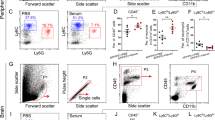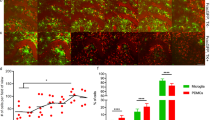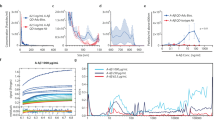Abstract
Inflammation is a pathological hallmark of Alzheimer's disease, and innate immune cells have been shown to contribute to disease pathogenesis. In two transgenic models of Alzheimer's disease (5xFAD and 3xTg-AD mice), neutrophils extravasated and were present in areas with amyloid-β (Aβ) deposits, where they released neutrophil extracellular traps (NETs) and IL-17. Aβ42 peptide triggered the LFA-1 integrin high-affinity state and rapid neutrophil adhesion to integrin ligands. In vivo, LFA-1 integrin controlled neutrophil extravasation into the CNS and intraparenchymal motility. In transgenic Alzheimer's disease models, neutrophil depletion or inhibition of neutrophil trafficking via LFA-1 blockade reduced Alzheimer's disease–like neuropathology and improved memory in mice already showing cognitive dysfunction. Temporary depletion of neutrophils for 1 month at early stages of disease led to sustained improvements in memory. Transgenic Alzheimer's disease model mice lacking LFA-1 were protected from cognitive decline and had reduced gliosis. In humans with Alzheimer's disease, neutrophils adhered to and spread inside brain venules and were present in the parenchyma, along with NETs. Our results demonstrate that neutrophils contribute to Alzheimer's disease pathogenesis and cognitive impairment and suggest that the inhibition of neutrophil trafficking may be beneficial in Alzheimer's disease.
This is a preview of subscription content, access via your institution
Access options
Subscribe to this journal
Receive 12 print issues and online access
$209.00 per year
only $17.42 per issue
Buy this article
- Purchase on SpringerLink
- Instant access to full article PDF
Prices may be subject to local taxes which are calculated during checkout






Similar content being viewed by others
References
Querfurth, H.W. & LaFerla, F.M. Alzheimer's disease. N. Engl. J. Med. 362, 329–344 (2010).
Selkoe, D.J. Alzheimer's disease is a synaptic failure. Science 298, 789–791 (2002).
Wyss-Coray, T. Inflammation in Alzheimer disease: driving force, bystander or beneficial response? Nat. Med. 12, 1005–1015 (2006).
Schwartz, M., Kipnis, J., Rivest, S. & Prat, A. How do immune cells support and shape the brain in health, disease, and aging? J. Neurosci. 33, 17587–17596 (2013).
Czirr, E. & Wyss-Coray, T. The immunology of neurodegeneration. J. Clin. Invest. 122, 1156–1163 (2012).
Krstic, D. & Knuesel, I. Deciphering the mechanism underlying late-onset Alzheimer disease. Nat. Rev. Neurol. 9, 25–34 (2013).
Kitazawa, M., Oddo, S., Yamasaki, T.R., Green, K.N. & LaFerla, F.M. Lipopolysaccharide-induced inflammation exacerbates tau pathology by a cyclin-dependent kinase 5-mediated pathway in a transgenic model of Alzheimer's disease. J. Neurosci. 25, 8843–8853 (2005).
in t' Veld, B.A. et al. Nonsteroidal antiinflammatory drugs and the risk of Alzheimer's disease. N. Engl. J. Med. 345, 1515–1521 (2001).
Szekely, C.A. & Zandi, P.P. Non-steroidal anti-inflammatory drugs and Alzheimer's disease: the epidemiological evidence. CNS Neurol. Disord. Drug Targets 9, 132–139 (2010).
Block, M.L., Zecca, L. & Hong, J.S. Microglia-mediated neurotoxicity: uncovering the molecular mechanisms. Nat. Rev. Neurosci. 8, 57–69 (2007).
Cagnin, A. et al. In-vivo measurement of activated microglia in dementia. Lancet 358, 461–467 (2001).
Hollingworth, P. et al. Common variants at ABCA7, MS4A6A/MS4A4E, EPHA1, CD33 and CD2AP are associated with Alzheimer's disease. Nat. Genet. 43, 429–435 (2011).
Lambert, J.C. et al. Meta-analysis of 74,046 individuals identifies 11 new susceptibility loci for Alzheimer's disease. Nat. Genet. 45, 1452–1458 (2013).
Jonsson, T. et al. Variant of TREM2 associated with the risk of Alzheimer's disease. N. Engl. J. Med. 368, 107–116 (2013).
Prokop, S., Miller, K.R. & Heppner, F.L. Microglia actions in Alzheimer's disease. Acta Neuropathol. 126, 461–477 (2013).
Zlokovic, B.V. Neurovascular pathways to neurodegeneration in Alzheimer's disease and other disorders. Nat. Rev. Neurosci. 12, 723–738 (2011).
Rossi, B., Angiari, S., Zenaro, E., Budui, S.L. & Constantin, G. Vascular inflammation in central nervous system diseases: adhesion receptors controlling leukocyte-endothelial interactions. J. Leukoc. Biol. 89, 539–556 (2011).
Savage, M.J. et al. Cathepsin G: localization in human cerebral cortex and generation of amyloidogenic fragments from the beta-amyloid precursor protein. Neuroscience 60, 607–619 (1994).
Togo, T. et al. Occurrence of T cells in the brain of Alzheimer's disease and other neurological diseases. J. Neuroimmunol. 124, 83–92 (2002).
Subramanian, S. et al. CCR6: a biomarker for Alzheimer's-like disease in a triple transgenic mouse model. J. Alzheimers Dis. 22, 619–629 (2010).
Baik, S.H. et al. Migration of neutrophils targeting amyloid plaques in Alzheimer's disease mouse model. Neurobiol. Aging 35, 1286–1292 (2014).
Michaud, J.P., Bellavance, M.A., Préfontaine, P. & Rivest, S. Real-time in vivo imaging reveals the ability of monocytes to clear vascular amyloid beta. Cell Reports 5, 646–653 (2013).
Oakley, H. et al. Intraneuronal β-amyloid aggregates, neurodegeneration, and neuron loss in transgenic mice with five familial Alzheimer's disease mutations: potential factors in amyloid plaque formation. J. Neurosci. 26, 10129–10140 (2006).
Oddo, S. et al. Triple-transgenic model of Alzheimer's disease with plaques and tangles: intracellular Aβ and synaptic dysfunction. Neuron 39, 409–421 (2003).
Oddo, S., Caccamo, A., Kitazawa, M., Tseng, B.P. & LaFerla, F.M. Amyloid deposition precedes tangle formation in a triple transgenic model of Alzheimer's disease. Neurobiol. Aging 24, 1063–1070 (2003).
Billings, L.M., Oddo, S., Green, K.N., McGaugh, J.L. & LaFerla, F.M. Intraneuronal Aβ causes the onset of early Alzheimer's disease-related cognitive deficits in transgenic mice. Neuron 45, 675–688 (2005).
Janelsins, M.C. et al. Early correlation of microglial activation with enhanced tumor necrosis factor-alpha and monocyte chemoattractant protein-1 expression specifically within the entorhinal cortex of triple transgenic Alzheimer's disease mice. J. Neuroinflammation 2, 23 (2005).
Green, K.N., Billings, L.M., Roozendaal, B., McGaugh, J.L. & LaFerla, F.M. Glucocorticoids increase amyloid-beta and tau pathology in a mouse model of Alzheimer's disease. J. Neurosci. 26, 9047–9056 (2006).
Mastrangelo, M.A. & Bowers, W.J. Detailed immunohistochemical characterization of temporal and spatial progression of Alzheimer's disease-related pathologies in male triple-transgenic mice. BMC Neurosci. 9, 81 (2008).
Phillipson, M. & Kubes, P. The neutrophil in vascular inflammation. Nat. Med. 17, 1381–1390 (2011).
Kolaczkowska, E. & Kubes, P. P. Neutrophil recruitment and function in health and inflammation. Nat. Rev. Immunol 13, 159–175 (2013).
Kebir, H. et al. Human TH17 lymphocytes promote blood-brain barrier disruption and central nervous system inflammation. Nat. Med. 13, 1173–1175 (2007).
Siffrin, V. et al. In vivo imaging of partially reversible th17 cell-induced neuronal dysfunction in the course of encephalomyelitis. Immunity 33, 424–436 (2010).
DiStasi, M.R. & Ley, K. Opening the flood-gates: how neutrophil-endothelial interactions regulate permeability. Trends Immunol. 30, 547–556 (2009).
Bolton, S.J., Anthony, D.C. & Perry, V.H. Loss of the tight junction proteins occludin and zonula occludens-1 from cerebral vascular endothelium during neutrophil-induced blood-brain barrier breakdown in vivo. Neuroscience 86, 1245–1257 (1998).
Kalaria, R.N. The blood-brain barrier and cerebrovascular pathology in Alzheimer's disease. Ann. NY Acad. Sci. 893, 113–125 (1999).
Gautam, N., Herwald, H., Hedqvist, P. & Lindbom, L. Signaling via beta(2) integrins triggers neutrophil-dependent alteration in endothelial barrier function. J. Exp. Med. 191, 1829–1839 (2000).
Ryu, J.K. & McLarnon, J.G. A leaky blood-brain barrier, fibrinogen infiltration and microglial reactivity in inflamed Alzheimer's disease brain. J. Cell. Mol. Med. 13, 2911–2925 (2009).
Ley, K., Laudanna, C., Cybulsky, M.I. & Nourshargh, S. Getting to the site of inflammation: the leukocyte adhesion cascade updated. Nat. Rev. Immunol. 7, 678–689 (2007).
Silva, M.T. Neutrophils and macrophages work in concert as inducers and effectors of adaptive immunity against extracellular and intracellular microbial pathogens. J. Leukoc. Biol. 87, 805–813 (2010).
Soehnlein, O. & Lindbom, L. Phagocyte partnership during the onset and resolution of inflammation. Nat. Rev. Immunol. 10, 427–439 (2010).
Kessenbrock, K. et al. Netting neutrophils in autoimmune small-vessel vasculitis. Nat. Med. 15, 623–625 (2009).
Garcia-Romo, G.S. et al. Netting neutrophils are major inducers of type I IFN production in pediatric systemic lupus erythematosus. Sci. Transl. Med. 3, 73ra20 (2011).
Allen, C. et al. Neutrophil cerebrovascular transmigration triggers rapid neurotoxicity through release of proteases associated with decondensed DNA. J. Immunol. 189, 381–392 (2012).
Baldwin, K.J. & Hogg, J.P. Progressive multifocal leukoencephalopathy in patients with multiple sclerosis. Curr. Opin. Neurol. 26, 318–323 (2013).
Sterniczuk, R., Antle, M.C., Laferla, F.M. & Dyck, R.H. Characterization of the 3xTg-AD mouse model of Alzheimer's disease: part 2. Behavioral and cognitive changes. Brain Res. 1348, 149–155 (2010).
Halagappa, V.K. et al. Intermittent fasting and caloric restriction ameliorate age-related behavioral deficits in the triple-transgenic mouse model of Alzheimer's disease. Neurobiol. Dis. 26, 212–220 (2007).
Nakashima, A.S., Oddo, S., Laferla, F.M. & Dyck, R.H. Experience-dependent regulation of vesicular zinc in male and female 3xTg-AD mice. Neurobiol. Aging 31, 605–613 (2010).
Robertson, R.T. et al. Amyloid-beta expression in retrosplenial cortex of triple transgenic mice: relationship to cholinergic axonal afferents from medial septum. Neuroscience 164, 1334–1346 (2009).
España, J. et al. Intraneuronal β-Amyloid accumulation in the amygdala enhances fear and anxiety in Alzheimer's disease transgenic mice. Biol. Psychiatry 67, 513–521 (2010).
Kim, H.J. et al. Selective neuronal degeneration induced by soluble oligomeric amyloid beta-protein. FASEB J. 17, 118–120 (2003).
Bolomini-Vittori, M. et al. Regulation of conformer-specific activation of the integrin LFA-1 by a chemokine-triggered Rho signaling module. Nat. Immunol. 10, 185–194 (2009).
Lundqvist, H. & Dahlgren, C. Isoluminol-enhanced chemiluminescence: a sensitive method to study the release of superoxide anion from human neutrophils. Free Radic. Biol. Med. (Paris) 20, 785–792 (1996).
Fumagalli, L. et al. Class I phosphoinositide-3-kinases and SRC kinases play a nonredundant role in regulation of adhesion-independent and -dependent neutrophil reactive oxygen species generation. J. Immunol. 190, 3648–3660 (2013).
Flister, M.J. et al. Inflammation induces lymphangiogenesis through up-regulation of VEGFR-3 mediated by NF-κB and Prox1. Blood 115, 418–429 (2010).
Kook, S.-Y. et al. Aβ1–42-RAGE interaction disrupts tight junctions of the blood–brain barrier via Ca2+-calcineurin signaling. J. Neurosci. 32, 8845–8854 (2012).
Ohira, K., Takeuchi, R., Iwanaga, T. & Miyakawa, T. Chronic fluoxetine treatment reduces parvalbumin expression and perineuronal nets in gamma-aminobutyric acidergic interneurons of the frontal cortex in adult mice. Mol. Brain 6, 43 (2013).
Kawarabayashi, T. et al. Age-dependent changes in brain, CSF, and plasma amyloid β protein in the Tg2576 transgenic mouse model of Alzheimer's disease. J. Neurosci. 21, 372–381 (2001).
Acknowledgements
We thank C. Laudanna (University of Verona) for providing the reagents to measure LFA-1 integrin affinity in human neutrophils. This work was supported by funding under the European Research Council grant 261079-NEUROTRAFFICKING (G.C.), Fondazione Cariverona (G.C.) and the European Community FP7 grant 282095-TARKINAID (G.B.). S.D. received a fellowship from the Fondazione Italiana Sclerosi Multipla, Genoa, Italy.
Author information
Authors and Affiliations
Contributions
G.C., E.Z and E.P. designed the experiments and analyzed the data. E.Z., E.P., V.D.B., G.P., S.B., E.T., B.R., S.A., S.D., A.M., L.M. and T.C. performed the experiments. G.B. and S.N. provided expertise in neutrophil extracellular traps. D.C. provided 129/C57BL6 mice. G.T. and L.C. analyzed the proximity between amyloid plaques and MPO+ cells. B.B. provided human tissue samples. E.Z. and G.C. wrote the paper.
Corresponding author
Ethics declarations
Competing interests
The authors declare no competing financial interests.
Supplementary information
Supplementary Text and Figures
Supplementary Figures 1–6 and Supplementary Table 1 (PDF 9790 kb)
Rights and permissions
About this article
Cite this article
Zenaro, E., Pietronigro, E., Bianca, V. et al. Neutrophils promote Alzheimer's disease–like pathology and cognitive decline via LFA-1 integrin. Nat Med 21, 880–886 (2015). https://doi.org/10.1038/nm.3913
Received:
Accepted:
Published:
Issue Date:
DOI: https://doi.org/10.1038/nm.3913
This article is cited by
-
Single cell transcriptome analysis identified a unique neutrophil type associated with Alzheimer’s disease
Immunity & Ageing (2024)
-
Exploring Imaging Genetic Markers of Alzheimer’s Disease Based on a Novel Nonlinear Correlation Analysis Algorithm
Journal of Molecular Neuroscience (2024)
-
The effects of high plasma levels of Aβ1-42 on mononuclear macrophage in mouse models of Alzheimer’s disease
Immunity & Ageing (2023)
-
Increased neutrophils in inflammatory bowel disease accelerate the accumulation of amyloid plaques in the mouse model of Alzheimer’s disease
Inflammation and Regeneration (2023)
-
Microglia-mediated T cell infiltration drives neurodegeneration in tauopathy
Nature (2023)



